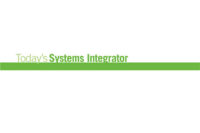Big data has arrived, and security integrators are increasingly assisting security directors and IT professionals with data installation. Indeed, there are viable ways for security integrators to supplement their projects with data installation. Yet, as with any opportunity, there are also critical challenges for integrators to consider.
David Santiago, physical security risk director at The Network Installers and Safe and Sound Security, recently sat down with two forward-thinking security integrators for SDM to discuss the challenges and opportunities that integrators face when offering both security and data installations.
The following conversation features Rich Campbell, a training and development specialist at San Jose, Calif.-based RFI, and Jon Polly, chief solutions officer at Charleston, S.C.-based ProTecht Solutions. From an operational perspective, Santiago and his guests explore how security integrators can supplement their projects with data installations, plus they spotlight some of the challenges and opportunities these types of projects present for security integrators.
Santiago: How do you think security integrators can supplement their projects with data installation projects?
Polly: With much skill and precision. Security integrators can do this very easily, yet they need to be good at it. The end user will not be receptive if the data cables fail certification or slow them down. Security integrators can easily do this, and yet in the words of Yoda, “Do or do not, there is no try.”
Data cabling is still low voltage, but unlike traditional security, intrusion or fire projects, data projects can require significant resources, human and other, to implement.
A simple question to the integrator, do you terminate Cat6 with scissors or wire strippers? Most security integrators train on wire strippers. Most data companies train using scissors. Both are equally right, and yet it defines the type of company.
The integrators that are successful in implementing data installation may want to look into state contracts and E-Rate programs that apply to schools and libraries.
It is a project and requires project management. Unlike many security departments where project management is an afterthought, IT departments know project management, know how to do it well, will have strict guidelines, and expect the integrator to do the same if the integrator is offering services to IT departments. Therefore, integrators must have a strong project management background to compete.
Campbell: As low voltage installers, we can work with the telecom industry and subcon [subcontract] with ISPs. Since functioning cloud-based services require data connectivity, integrators can use various methods to manage data installation projects. One approach is to work directly with an internet service provider to sell and set up that service and the internet circuits. We can also resell and install their services with internet-based and cellular services. So we have things like 4G, LTE and 5g cellular services that we resell. We partner with manufacturers to get equipment compatible with those services to help their devices communicate.
Santiago: That’s excellent information and very helpful for security directors that don’t work directly with ISPs, etc. From your perspective, what are the pros and cons of data installation projects?
Polly: Pros: Connectivity runs every business. IT has more budget and influence than security, and tapping into that funding source can only bring better and ongoing business to the integrator. Data cabling also only requires a low voltage license and not alarm licenses like some states require for security integrators.
Cons: Pulling the cable is one thing, but terminating thousands of cables can be time-consuming. Data installation also typically requires the integrator to install and program the network switches; using command line interface [CLI] and product-specific certifications such as the Cisco CCNA.
The integrators who successfully do this typically have a data side of the business that handles this part of the business. All integrators should also look ahead at cyber-hardening their systems, with all employees eventually having a Security Industry Cybersecurity Certification (SICC). Additionally, on the data side, this is typically a step further with an (ISC)2 or CompTIA certification as customers will mandate this as part of the installation and commissioning phase.
Data cabling has to be certified before most end users accept the cable as fully commissioned. Certification meters from Fluke, AFL and others can range between $15K-$35K, and require recertification every three years.
Campbell: Pro: Integrators become that indispensable security professional/advisor for their clients. Here’s a good example: For an installation to be successful, the client needs to talk to their IT provider, their internet service provider and their management. They may also need to speak to their fire alarm company or their alarm company, etc. So that’s a lot of different contacts, variables, and possible challenges. If we can be that one-stop service provider for our clients, we can optimize the vendor-client relationship.
Con: By providing data installation services, we are increasing our exposure and managing many moving parts. This may create additional challenges impacting delivery, project management, and visibility issues. For example, Let’s say we have that conversation with the customer about installing their internet service. Getting everything up and running totally depends on that internet circuit being active 100 percent. In this case, we will have to rely on that internet service provider to keep their end of the bargain. If they slip? Well, the entire project can fail.
Santiago: Looking ahead, what’s your take on the future of data installation projects in the context of accelerating cyber-physical convergence?
Polly: Data installation is going to continue and grow as IoT applications grow. It is a numbers game, if there are a billion more networked sensors, there is going to need to be more connectivity to those sensors. The caveat is that many of the IoT devices are purpose-built battery-powered sensors that communicate back to a set of gateways.
The gateways are the only device with cabling, and even then, some gateways offer cellular connectivity because the sensors cannot meet corporate security requirements. Data installation is going to continue. That is certain. It may change from hardwired boxes to wireless access points, but the more devices used, the more coverage and cabling projects will be required.
The bottom line is that regulations and regulating bodies will help define how data installation projects are accelerated.
Campbell: Currently, there are over 40 billion devices on the internet. Additionally, there are approximately 8 to 11 devices on the internet for each breathing body on the planet. And so we really don’t have a choice anymore. We must figure out a way to adapt, become cybersecurity aware, and express that commitment to our customers.
An excellent example of this is our new onboarding program. When we bring a new technician or a new installer into the industry, we have them go through cybersecurity awareness training and IT training. The new technician has to understand networks, IP addressing, antivirus, malware and all these sorts of things that you deal with in the IT space. You have to learn how to adapt.
Santiago: For security integrators contemplating focusing more on data installations, what is a good first step?
Campbell: Well, the very first step is to educate yourself, as an integrator, about data installations because you want to be that expert advisor for your client. Once you have a firm understanding of data installation, you want to have an initial conversation with your client. Ask the client, who handles their internet service because you want to know what's working and possible challenges.
After you’ve completed a few projects, you want to assess the pros and cons and then decide if data installation projects are really worth investing time and resources into moving forward.
David Santiago, physical security risk director at The Network Installers and Safe and Sound Security, is a certified security professional and military veteran with extensive experience in security operations and risk management. As a security director, he led teams in high-risk environments and worked with security professionals at the highest levels of the government, including the U.S. State Department.






